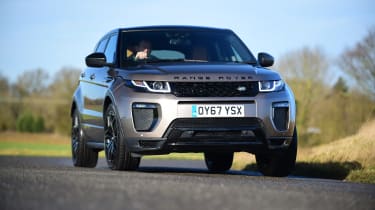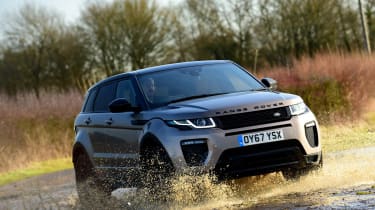Range Rover Evoque (2013-2019) review – with once exotic style now familiar, does the Evoque still have what takes? - Ride and Handling
Concept car looks and a luxurious interior compensate for some less than inspiring handling
The Evoque does an excellent job of providing drivers with a stepping-stone into the full-fat Range Rover experience.
Sadly it can’t compete with the likes of BMW’s X3 or Audi’s Q5 for absolute driver engagement. But nothing in this sector is the last word in dynamic brilliance.
The Evoque has surprisingly taught body control. On twisty roads the it contains its 1655kg mass (in three door diesel guise) quite well. It corners flatly, exhibiting little of the disconcerting roll you’d expect with such a high ride-height. However grip is easily overcome, and the front will wash wide if you carry to much speed into a corner. The engines simply don’t have the performance to worry the front tyres out of a corner. The four-wheel drive models then, have more than enough traction.
Despite having a similar four-wheel drive system as a Ford Focus RS, it couldn’t feel much more different. Both have been calibrated to achieve such different results, and it highlights the sheer adaptability of the GKN system.
Beneath the sleek exterior it’s still a Land Rover so feels robust and dependable, if a bit cumbersome at an increased pace.
The Evoque’s new, lighter aluminium Ingenium engines have allowed engineers to revise the rear suspension bushes and in turn create a smoother and more compliant ride. Also new for the 2016 model year cars are larger brakes, with all but the entry level two-wheel drive car benefitting from four piston calipers mated to 325mm discs at the front and 317mm at the rear.
More reviews
In-depth reviews
- Range Rover 2025 review – there’s no need to go electric
- Range Rover review (L405, 2012-2021) – verdict, specs and rivals
- Range Rover Sport review
Long term tests
Reviews
The Evoque’s interior isolates its passengers from the road beneath, keeping road and tyre noise to a minimum. Push the diesel motors and they do make themselves known, but mostly they’re quiet and refined. There is some noticeable wind noise from the side mirrors, however.
Sat on standard 19-inch wheels (20 and 21-inch are optional), the ride is smooth and compliant. Smaller lumps and bumps are absorbed well, while bigger undulations don’t appear to unstick the Evoque too badly.
We also tested both the two-wheel drive manual eD4 Evoque and four-wheel drive TD4 auto off-road. It’s here where the Evoque impresses. It’s easy to forget, given how many you spot about town, that it’s actually capable of going off-road at all. Sending the car through a 500mm deep wading pool quickly reminds you of its capabilities.
Land Rover’s ‘All Terrain Progress Control’ is also new for 2016. A sort of off-road cruise control normally found on the more expensive models in the Range Rover line up, it allows you to creep along at a desired speed (at a maximum speed of 19mph) and with vehicle’s electronics controlling descent speeds, braking and throttle inputs while you simply steer. How many Evoque users will ever put the system to use we’re not so sure, but it’s impressive to see such advanced 4WD technology making its way on to entry-level Range Rovers.
Ultimately the Evoque just isn’t that exciting to drive. It’s much more at home about town or on the motorway (likely where most will find themselves), offering decent refinement and comfort for the money.



